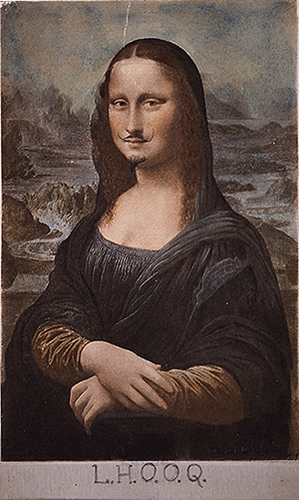“Memento
Mona” 2008
This piece of work evolved out a project concerning appropriation in
art, in which several artists were invited to work with an image that
is arguably the most well-known and familiar in Western art.
 Much of its initial construction came about by chance: while I was
working on it, I was given a discarded shoe, which I realised was
proportionate to the face: having removed the face, I realised that
it fit exactly, on its side, into the décolletage: having done this,
I realised that the postcard size I had of the face fit exactly into
the eye. The background I replaced with a collage of Van Gogh landscapes, and the text was taken from a reworking of Walter Benjamin's "Arcades Project" by Steffan Boehm - the face collaged with 'The Prostitute', and the cut-up from 'The Collector'.
Much of its initial construction came about by chance: while I was
working on it, I was given a discarded shoe, which I realised was
proportionate to the face: having removed the face, I realised that
it fit exactly, on its side, into the décolletage: having done this,
I realised that the postcard size I had of the face fit exactly into
the eye. The background I replaced with a collage of Van Gogh landscapes, and the text was taken from a reworking of Walter Benjamin's "Arcades Project" by Steffan Boehm - the face collaged with 'The Prostitute', and the cut-up from 'The Collector'.
The piece as a whole represents several interests that I was
exploring or developing at the time: assemblage, collage, text,
cut-ups, and the Vanitas.
The bouquet turns the notion of a gift of flowers on its head through usage of traditional Vanitas metaphors - the skull (here, a rabbit's, complete with ears), the guttering candle replaced by a burnt-out light bulb, the dead flowers, the pheasant's tail - representing the bird as psychopomp. Working with found or reclaimed objects,
working with animal remains as metaphors for human experiences, to create new narratives out of old icons.
 It's a piece of art that has been interpreted by viewers in any
number of ways. Some see the shoe as a symbol of the Nazi
concentration camp victim, others as representative of a lost
childhood. The fact of the shoe in the face inspired its usage to
illustrate a paper about organisational politics. The removal of the famous face has been seen as a political statement
in itself; and the addition of the Vanitas bouquet, as a memento mori
- for the death of art, of the meaning of art: for where is the 'aura'
of an artwork that has been so reproduced and defiled?
It's a piece of art that has been interpreted by viewers in any
number of ways. Some see the shoe as a symbol of the Nazi
concentration camp victim, others as representative of a lost
childhood. The fact of the shoe in the face inspired its usage to
illustrate a paper about organisational politics. The removal of the famous face has been seen as a political statement
in itself; and the addition of the Vanitas bouquet, as a memento mori
- for the death of art, of the meaning of art: for where is the 'aura'
of an artwork that has been so reproduced and defiled?
I had hoped, with this work, to make the viewer reconsider his or her
relationship to the familiar, to create uncanniness out of the homely
by 'defacing' the iconic visage. But in the end - as with many artworks that are not either
politically didactic or purely decorative - I hope that the viewer
will create their own meaning, narrative, or relationship with the
work.
Marcel Duchamp "L.H.O.O.Q." 1919
Further reading:
Boehm, Steffan The Consulting Arcade: Walking Through Fetish-Land
http://peaceaware.com/tamara/issues/volume_2/issue_2_2/Bohn_ConsultingArcade.pdfN. Butler, C. Land and M. Sliwa “Throwing Shoes...” http://www.ephemeraweb.org/journal/9-3/9-3editorial.pdf
Benjamin, Walter “The Work of Art in the age of its Technological Reproducibility and other writings on media” and "The Arcades Project"
Freud, Sigmund “The uncanny”(1919) in Art and Literature London: Penguin 1990


